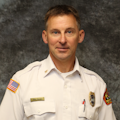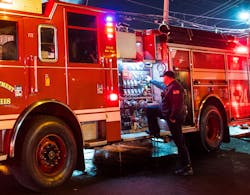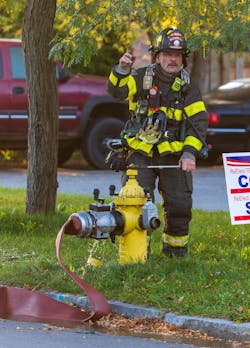Mathematics prepare us to become thinking firefighters.
Being a math guy, I find it difficult to understand how anyone can say, “I’m not a math person” or “I’ll never use this stuff.” I understand that some might think that it’s of little value, but I will argue that mathematics has its place in the fire service.
Merriam-Webster defines mathematics as the science of numbers. As we look throughout history, mathematics is revealed in many ways—from engineering the Egyptian pyramids, to designing modern construction, to budgeting personal finances. Mathematics plays a great part in the foundation of everything, including the many facets of the fire service. Mathematics is more than just working with numbers. It helps us to become critical thinkers. Critical thinking is the ability to resist freelancing and instead look carefully at the cues on the emergency scene, consider multiple interpretations of that information and come to a conclusion that leads to a successful outcome.
Laying the groundwork
Mathematics has four familiar basic rules: addition, subtraction, multiplication and division. We use these rules as we progress through more complex problems that are found in algebra and geometry, among others, and in the fire service to determine, for example, fire flow calculations, pre-incident planning and pump operations. In algebra and elsewhere, we find additional rules that help us to navigate to the correct answer or positive outcome. These rules prepare us to solve fireground problems, such as a needed fire flow, and in our personal finances to help us to understand retirement values as we compare our salaries with years of service.
The commutative rules of addition and multiplication say that we can add or multiply two numbers or objects in any order. For example, if we have two hoselines flowing, one at 150 gpm and another at 125 gpm, we know that we have a total of 275 gpm flowing. This is simple addition of 150 + 125 = 275 or 125 + 150 = 275. When we look at multiplication, it simply is two numbers multiplied by each other. In this case, if we have two handlines, both flowing 150 gpm, we can determine that we have a total of 300 gpm flowing. This equation looks like 2 x 150, or in other words, 150 + 150 = 300. Although impractical, if we had 150 handlines flowing at 2 gpm each (150 x 2), we would have the same total gpm of 300. The associative rule of addition and multiplication builds on the commutative rule and provides that three or more numbers can be added or multiplied together in any order. The equation 200 + 150 + 125 will have the same result as 150 + 200 + 125.
Order and purpose
The distributive rule is where mathematics begins to prepare us to be critical thinkers. The distributive rule of multiplication says that when two numbers are added together and then multiplied by another number, the result is the same as the sum of their products with the number individually. In firefighter’s terms, let’s say that four handlines are flowing on opposite sides of a structure. Two handlines are flowing on the A side, one at 150 gpm and the other at 125 gpm. The D side has the same combination of lines flowing. Knowing this information, we can write the algebraic formula as 2 x (150 + 125) or (2 x 150) + (2 x 125). Both calculate to a total gpm flowing of 550. Because the 150 gpm and 125 gpm numbers are alike and grouped together, this rule works. If we were to work the equation out of order, it might look like 2 x 150 + 125. Calculating this from left to right equals 425, which doesn’t agree with the distributive rule.
Understanding the basics of the distributive rule prepares us to do things in order and for a purpose. If you think in nonmathematical terms, when you break the defined rules on the fireground (i.e., fire department policy and procedures), you shouldn’t be surprised when the operation fails or doesn’t go as planned.
Firefighting basics
Mathematical rules drive us to the correct answer just as tasks on an emergency incident provide the needed steps to bring the incident to a close. Although these steps might be performed in different orders based on incident priorities, many tasks must be completed in a defined order so as to produce a successful outcome.
As a probationary firefighter, we learned the basics of firefighting and operating the different equipment on fire apparatus. Training officers and senior firefighters guide probationary firefighters with the step-by-step procedures that provide the foundation for their role as a firefighter. As probationary firefighters progress, the basic individual skills are put together to form critical fireground tasks.Pump operations
Operating fire pumps is more technical than just getting water out of the apparatus. The days of getting water to the nozzle, cranking it up until the firefighter comes off of the ground and then turning it down to set the firefighter’s feet back on the ground shouldn’t be encouraged. It’s a dangerous and risky way to provide water.
Understanding friction loss in fire hose and appliances is critical to creating proper—and safe—fire flows at working fires. Regardless of whether your organization subscribes to the 100-psi fog, the 40–60-psi smooth bore or the automatic nozzle, the pump operator must understand how to make the nozzle function as designed.
As fireground fuel load has increased with modern interior features, it’s critical that we deliver an adequate amount of water to stop or slow fire progression. The pump operator uses mathematics and friction-loss formulas to determine proper flows for pre-connected hoselines and pump charts. Knowing these pressure calculations ahead of an emergency allows the pump operator not only to provide the needed water but also to understand changes, such as extending or adding lines, that the incident commander might call during the incident. Mathematics prepares pump operators to work out mathematical equations as well as to be critical fireground thinkers.Critical thinking officer
As fire officers, we must look at the desired results of an emergency response and calculate how we get there. The basic elements of firefighting and rescue operations, as compared with parts of a mathematical equation, provide the path to success on the fireground. Mathematics trains us to become critical thinkers, so when we are confronted with complex problems that might be different than what we expect on arrival, we quickly can call an audible to address the fireground problem.
Critical thinking at all levels of the fire service is crucial. Through training and education, and particularly mathematics, we prepare ourselves for complex issues. We rarely arrive to exactly what the communications center sent us. It very likely is that units that are dispatched to an automatic fire alarm find smoke showing on arrival, or they are dispatched to a noninjury accident only to arrive to find multiple injuries and a large fluid spill. For this reason, it’s mission-critical that first-arriving responders are prepared to make decisions that are based on their windshield size-up and communicate those decisions to incoming units.
Mathematics is more than just some required course in a degree plan. It’s an important piece of the fire service puzzle that helps to train us to become thinking firefighters, pump operators and fire officers. Mathematics, along with the other general education courses that we take, teaches us to logically break down complex problems (i.e., emergency incidents), so we may better serve our community, our organization and fellow firefighters. So, don’t discount mathematics. Its value reaches further than just putting some numbers together and arriving at the correct answer.
About the Author

Mike Novak
Mike Novak is the division chief of training and safety for Branson, MO, Fire Rescue. His areas of responsibility with Branson include training program management as well as health and incident safety. Novak serves as the Region 7 Volunteer Advocate Manager for the National Fallen Firefighters Foundation’s Everyone Goes Home program, an adjunct instructor for the University of Missouri's Fire Rescue Training Institute, and a regional sales and training associate with Pleiadian Systems. He holds a master’s degree in public administration in emergency services administration and is credentialed as a Chief Fire Officer through the Center for Public Safety Excellence and as an Executive Fire Officer through the National Fire Academy. He presented on VR training at the inaugural FireFusion conference in November 2024.


